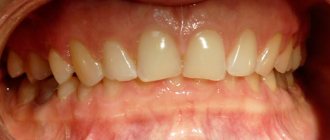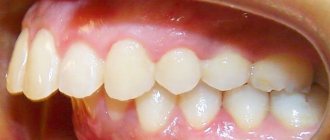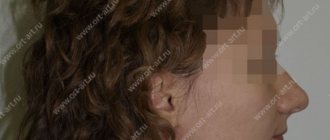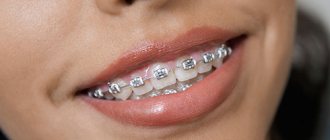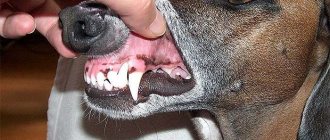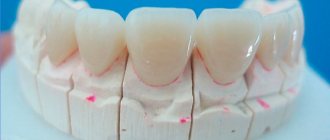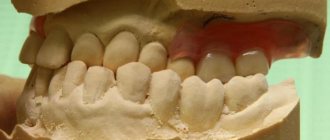2049
Myogymnastics in orthodontics is one of the most effective ways to treat and prevent anomalies of the dental system. Effective for dysfunction of facial and masticatory muscles, as well as joints of the mandibular and temporal groups .
Malocclusion is corrected using a special set of exercises.
What it is?
Myotherapy is a technique for correcting and preventing malocclusion. This method is based on regular impact on various muscle groups of the jaw apparatus using special exercises.
According to its characteristics, therapy refers to physical therapy, which uses exercises developed by orthodontic specialists.
The peculiarity of this technique is that it can be used as both an independent and an additional means of correction.
How can myotherapy help?
Physical therapy for the muscles surrounding the oral cavity is called myotherapy. Myotherapy is an effective treatment method in orthodontics. Exercises are performed to normalize muscle function and train the correct position of the lips and tongue. Read more about other methods of treating malocclusion.
The method is based on maintaining myodynamic balance - the muscle strength in and outside the oral cavity should be approximately the same. If this harmony is maintained, then the jaws grow and develop correctly. If myodynamic balance is disturbed, the muscles provoke the development of dentofacial anomalies.
Muscle dysfunction occurs as a result of bad habits:
- sucking lips, tongue, finger, household objects;
- improper tongue placement;
- infantile type of swallowing;
- mouth breathing;
- chewing or speech disorders.
There are two methods of treatment using myotherapy:
- At home, with the help of family members who have learned the exercises from the attending orthodontist and can independently practice with the child. The disadvantage of treatment is the inability to control the regularity and correctness of physical therapy.
- Treatment in a clinic or kindergarten with the help of a nurse or assistant. To do this, a group of children with the same dental anomalies or risk factors for their occurrence is formed. Daily exercise classes are conducted with children.
Expected Result
As a result of constant muscle training, all physiological processes of the jaw apparatus improve:
- Mechanisms of compensatory action are formed .
- The biological growth of the muscle system and bone tissue is stimulated .
- Functional characteristics are normalized .
- Trophic processes improve .
Thanks to the complex effect of constant myogymnastics, all muscle work is adjusted to the correct one, and the bones begin to develop correctly, which leads to the restoration of the position of curved crowns and the correction of an abnormal bite.
Indications and contraindications
The main indications for the use of myotherapy include:
- abnormal bite of the first degree . Therapy is effective for any type of anomaly;
- insufficient development of the facial muscles ;
- incorrect position of the crowns in relation to the general row ;
- dysfunction of the tongue and orbicularis oris muscle;
- improper functioning of the TMJ .
Look at the photo to see what a person’s correct bite should be. Information manual for patients.
This article contains treatment that will help with distal occlusion.
The link https://zubovv.ru/ortodontiya/prikus/ot-chego-obrazuetsya-i-kak-lechitsya-perekrestnyiy.html describes a cross bite with a displacement of the lower jaw.
The use of myotherapy is not recommended in the following cases:
- impaired mobility of the jaw joint;
- hypertrophy of facial muscles caused by pathologies;
- malocclusion of the third degree ;
- abnormal development of the jaw due to previous general diseases.
Advantages and disadvantages of the method
The main advantage of this technique is that the adjustment can be carried out without the use of orthodontic appliances. Thanks to this, the child does not experience psychological or physical discomfort.
This eliminates injury to mucous membranes and damage to dental tissue .
The disadvantages of myotherapy include:
- duration of treatment;
- low efficiency in relation to pronounced anomalies;
- in the absence of consistency, regression quickly occurs.
Who is it suitable for?
The use of this technique can give the most positive results only when treating children aged 4 to 7 years . During this period, active growth of the jaw and its muscles occurs, which respond well to the influence of soft methods.
It should be borne in mind that the older the child, the longer the treatment process will take. At an older age, it is most rational to use gymnastics as an additional technique .
When eliminating orthodontic problems in adults with a mature bite, myogymnastics will not have any effect .
Efficiency and implementation rules
The positive result of the exercises directly depends on the level of development of the pathology, as well as on the regularity and quality of the gymnastics performed. It is subject to the following set of requirements:
- Muscular contraction of the oral cavity with the maximum possible amplitude is mandatory.
- It is important to consider that contractions must be carried out within physiological limits.
- It is necessary after each exercise to take a pause equal to the time spent on it.
- Contractions should be repeated until slight fatigue appears.
The peculiarity lies in the training of special muscle groups that contribute to treatment, the so-called antagonists and synergists. Gymnastics allows you to achieve the necessary results in the prevention of children's anomalies of temporary occlusion.
That is why children from 4 years of age , who can already understand and perform the required tasks, are especially suitable for this form of treatment.
Subtleties
For this technique to be truly beneficial, it is necessary to take into account some nuances:
- Gymnastics should be carried out on the principle of gradually increasing the impact on the muscles and increasing the number of exercises. Therapy begins with the easiest exercises, gradually moving on to the most difficult ones;
- one of the important factors is consistency : gymnastics should be done every day and at the same hours;
- to increase efficiency during exercises, additional devices ;
- each movement must be accompanied by a maximum amplitude of movement;
- During movements, it is worth monitoring so that the speed of muscle contraction corresponds to the pause .
Exercises to correct your bite
For each type of malocclusion and other orthodontic problems, a different combination of exercises is used.
Deep bite
To correct it, use the following exercises, which are performed only in a standing position:
- Placing your hands behind your back and moving them back a little, straighten their back And stretch out the chin as far forward as possible. The best option would be for the anterior teeth to touch.
This situation must be maintained no less than 20 seconds. This movement is repeated for about 15 times with two intervals. Its implementation involves two stages. The first continues according to the described scheme for 30 days.Then they proceed to the second stage, in which, when moving forward, the teeth of the lower jaw should extend beyond the upper one.
- Take a position similar to the previous exercise and alternately push your jaw as far as possible and immediately slowly relax it. At least 10 such movements must be performed in one approach several approaches in one day .
- Raising your head slightly, slowly open your mouth close it just as slowly . The movements are repeated for at least 4 minutes . To increase efficiency, it is recommended to perform up to 5 such approaches during the day.
Open bite
Myogymnastics, aimed at stopping an open bite, includes exercises that correct the functioning of the muscles responsible for the movement of the lower jaw:
- The main exercise is to provide additional resistance when clenching your jaws .
To do this, open the mouth as wide as possible and place the fingers on the front crowns. When lifting the movable jaw, the fingers exert strong resistance, preventing the lips from closing. - The exercise consists of alternately clenching the teeth and weakening this movement until a pronounced feeling of fatigue appears. In this case, the fingers are placed on both cheeks in the cheekbone area.
- Clutching an object with teeth , performed with force. To do this, use a straight stick or pencil. In order to prevent injury to the enamel, it is recommended to put a rubber tube on the object being used. Such movements must be done for 5 minutes .
Mesial bite
When correcting mesial occlusion, the following exercises are used:
- Press the tip of the tongue onto the gum line of the lingual (inner) surface of the crowns. When pressing, the tongue is held for a few seconds . The exercise is continued for 5 minutes .
- Sit on a hard surface and tilt your head back . After this, open your mouth a little and at the same time touch the base of the hard palate with the front of your tongue.
- The lower lip is placed under the front row of teeth of the upper jaw , moving it as far into the mouth as possible.
The terrible consequences of malocclusion in adults. Clinical cases.
What results do ceramic braces give? Here are photos before and after treatment.
How many months does an adult need to wear braces? Here https://zubovv.ru/ortodontiya/breketyi/skolko-vremeni-nuzhno-nosit.html data on treatment time is presented.
Oblique bite
In the event that the occlusion is not symmetrical, the main therapeutic exercise is crossed closure of the jaws . To do this, open the mouth wide and in this position slowly move the jaw in the direction of non-closing.
After this, the mouth is slowly closed and are clenched as tightly . This position must be fixed for 50 seconds or more. Then relax the muscles and, after a pause, repeat the exercise again.
For muscles
In addition to exercises to correct the bite, myogymnastics includes complexes that allow you to train the internal muscles of the oral cavity and the orbicularis muscle.
Underdevelopment of the orbicularis oris muscle
To eliminate this problem, use a simple set of exercises:
- Imitating blowing out a candle or whistling, the lips are pulled out with a tube and this position is fixed for a few seconds. After this, you need to stretch your lips into a wide smile .
- As in the previous version, the lips are shaped into a tube and at the same time they try to pronounce complex and long words . The words are spoken for at least 30 seconds .
- They take air into their mouth and, closing it, roll the air under their lip . The exercise involves moving air from one lip to the other. The mouth should be tightly closed.
- Close your mouth tightly and clench your teeth , after which you take in air through your nose and fill your cheeks with it to the maximum. Then they place their palms on the cheeks and try to squeeze the air out of the mouth so that the mouth remains closed .
- Close your lips tightly and hold them in this position until fatigue appears.
For the muscles of the tongue
Three different groups of exercises are used for the tongue muscles. Each complex is indicated for influencing a separate segment of the tongue: anterior, middle, basal.
This video shows one of the sets of exercises:
A set of exercises for the anterior part of the tongue:
- It is necessary to extend the tongue , giving it the shape of a column a rubber ring on it .
Place the tongue on the gum line in the area of the alveolar process of the anterior section and make a movement as if swallowing. During the exercise, you need to perform 10 swallows. In this case, it is necessary to ensure that the rings do not move on the tongue. - With lips tightly closed, press with your tongue on the base of the alveolar ridge. Hold this position for 5 minutes.
A set of exercises for the middle section:
- To perform it, you need to use two rubber rings , which are placed on the tongue. After this, lips and teeth must be closed tightly, and the tongue should be reached to the surface of the palate and left in this position for 3 minutes.
- Clicking or clicking your tongue, which must be repeated at least 50 times. It is recommended to perform up to 6 such approaches per day.
Exercises for the basal part of the tongue:
- Imitate a yawn for at least 2 minutes or until a pronounced feeling of fatigue appears.
- Gargling with sounds.
For the posterior jaw protractor muscles
This type of exercise is performed while sitting in the first two weeks, then moves on to standing.
The whole complex is based on jaw extension, which is complemented by certain actions:
- The jaw is pushed forward to such an extent that the lower incisors overlap the upper front teeth. Fix this position for 10 seconds, and then gradually relax the jaw.
- They do the same as in the first case, only they complement the exercise by turning the head to the sides . Repeat the movement at least 10 times.
- This exercise is intended to be performed while standing. It is necessary to throw your head back and move your arms back. After adopting this position, the jaw should be extended to the line where the teeth meet.
For problems with lip closure
There are several basic exercises :
- When the lips are compressed tightly, it is necessary to perform rotational movements with the tongue under the lips.
- The extended tongue is placed on the surface of the lower lip, while the upper lip, when closed quickly, should hit the tongue.
- You need to press your tongue to the roof of your mouth and open your mouth with the maximum possible amplitude. When you close your lips, you need to make a sound reminiscent of a hammer.
Looking for reviews of Clarity braces? Here those who have used these systems share their experiences.
In the next article we will talk about the features of treating open bite in children.
Read the link to learn how to provide the necessary care for your braces after they are installed.
Each of the described exercises is performed first in a sitting position. As it becomes more difficult, you need to stand up.
An advanced gymnastics complex looks like this:
- The lower jaw moves forward until the lower incisors overlap the upper dentition.
This position is held for at least 10 seconds. After this, the jaw completely returns to its original position. - The previous exercise can be made more difficult by turning the head evenly. You should try to keep your jaw in an extended position.
- The head leans back, legs are set shoulder-width apart. The dentition moves forward until the marginal fusion of the jaw occurs.
Reviews
Myogymnastics has received positive reviews mainly from parents whose children have not reached the age of six. According to adult patients who used myotherapy for their treatment, it cannot be considered an effective technique.
We invite everyone to share their opinion about this technique in the comments to this article.
If you find an error, please select a piece of text and press Ctrl+Enter.
Tags: bite correction, myogymnastics, orthodontics
Did you like the article? stay tuned
